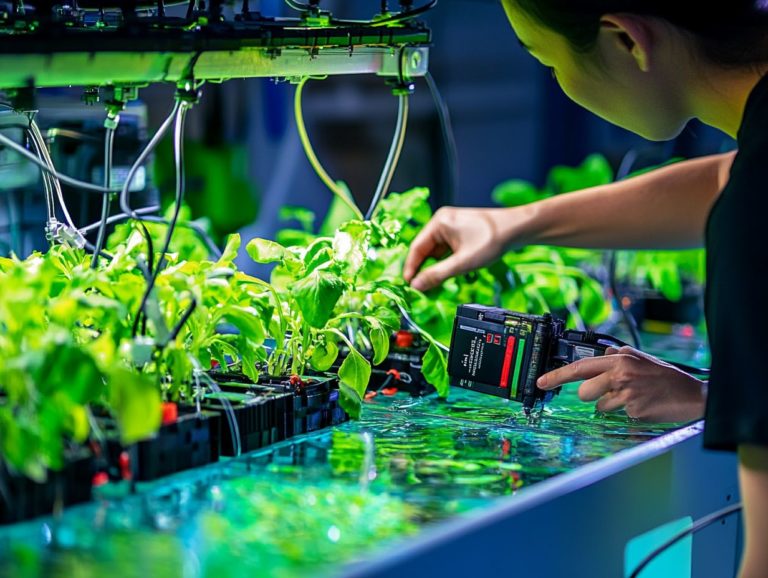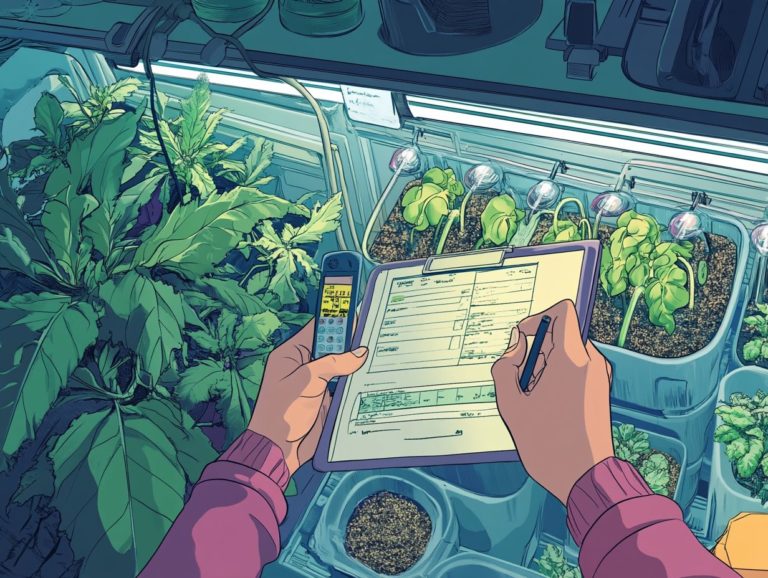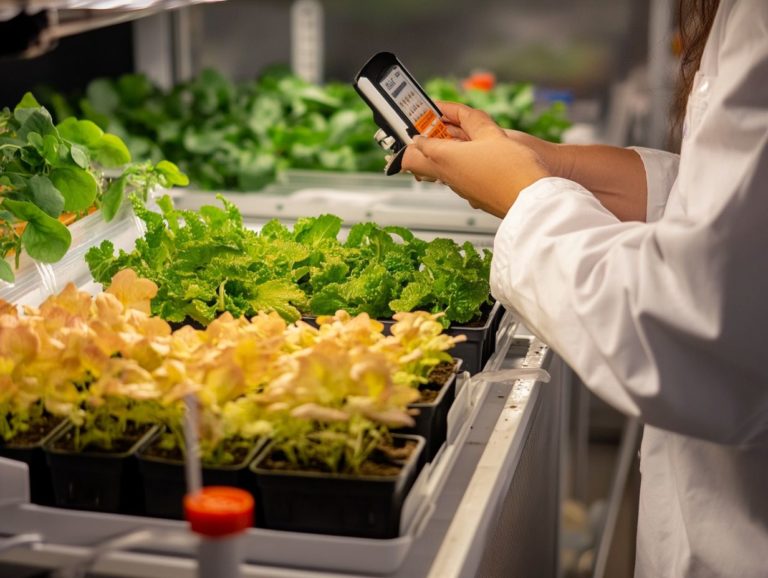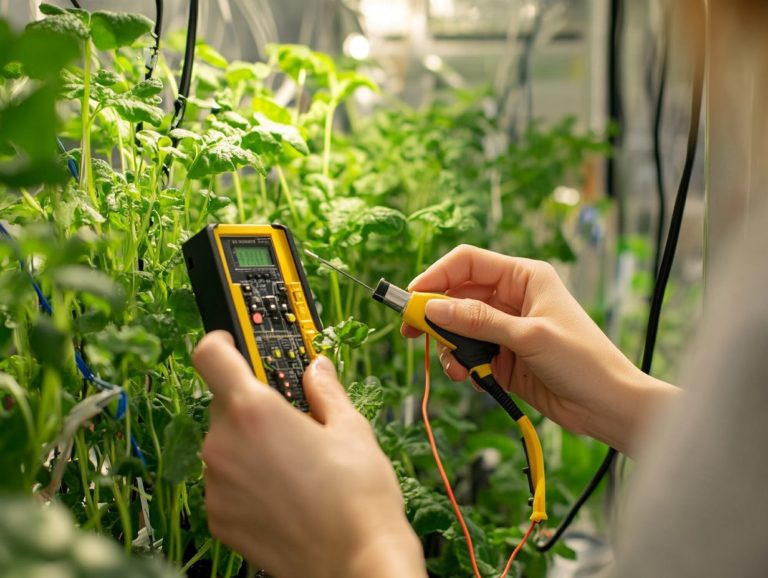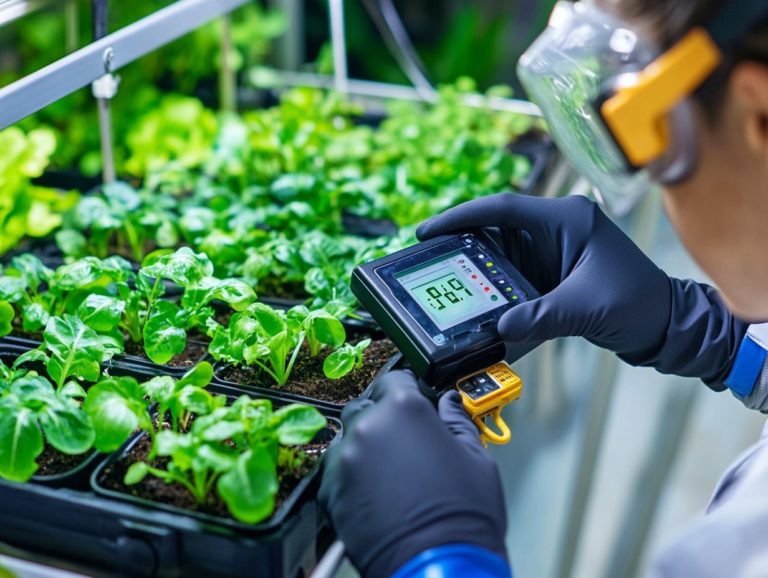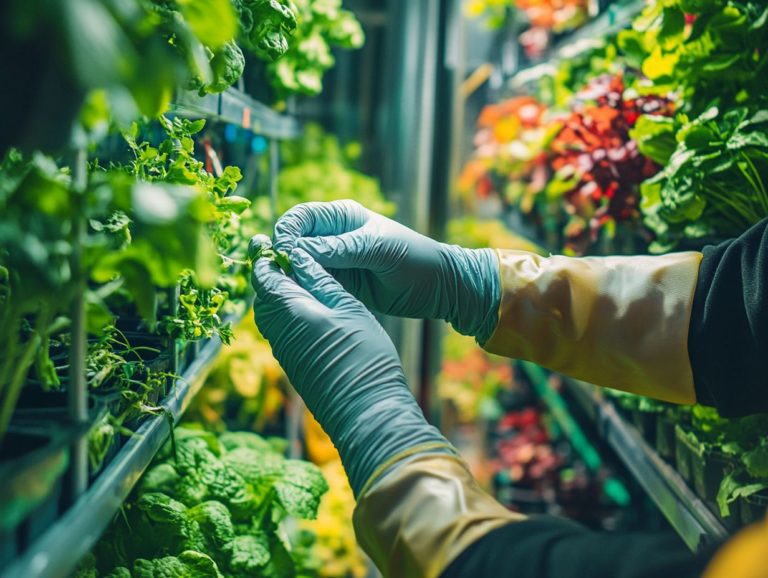How to Monitor EC Levels in Hydroponics
In hydroponics, grasping and managing Electrical Conductivity (EC) is essential for nurturing robust plants. EC levels reflect the concentration of nutrients in the water, which directly influences plant growth and yield.
This article delves into various methods for monitoring EC, ranging from manual testing with meters to sophisticated automated systems. You ll discover how to interpret EC readings for different plants, understand the factors that affect these levels, and explore strategies for maintaining optimal conditions. Dive into this knowledge to boost your hydroponic success!
Contents
- Key Takeaways:
- What is EC and Why is it Important?
- Methods for Monitoring EC Levels
- Interpreting EC Readings
- Factors Affecting EC Levels
- Maintaining Optimal EC Levels
- Frequently Asked Questions
- What are EC levels and why are they important in hydroponics?
- How can I measure EC levels in my hydroponic system?
- What is the ideal range for EC levels in hydroponics?
- How often should I monitor EC levels in my hydroponic system?
- What factors can affect EC levels in a hydroponic system?
- Can I reuse the nutrient solution in my hydroponic system?
Key Takeaways:
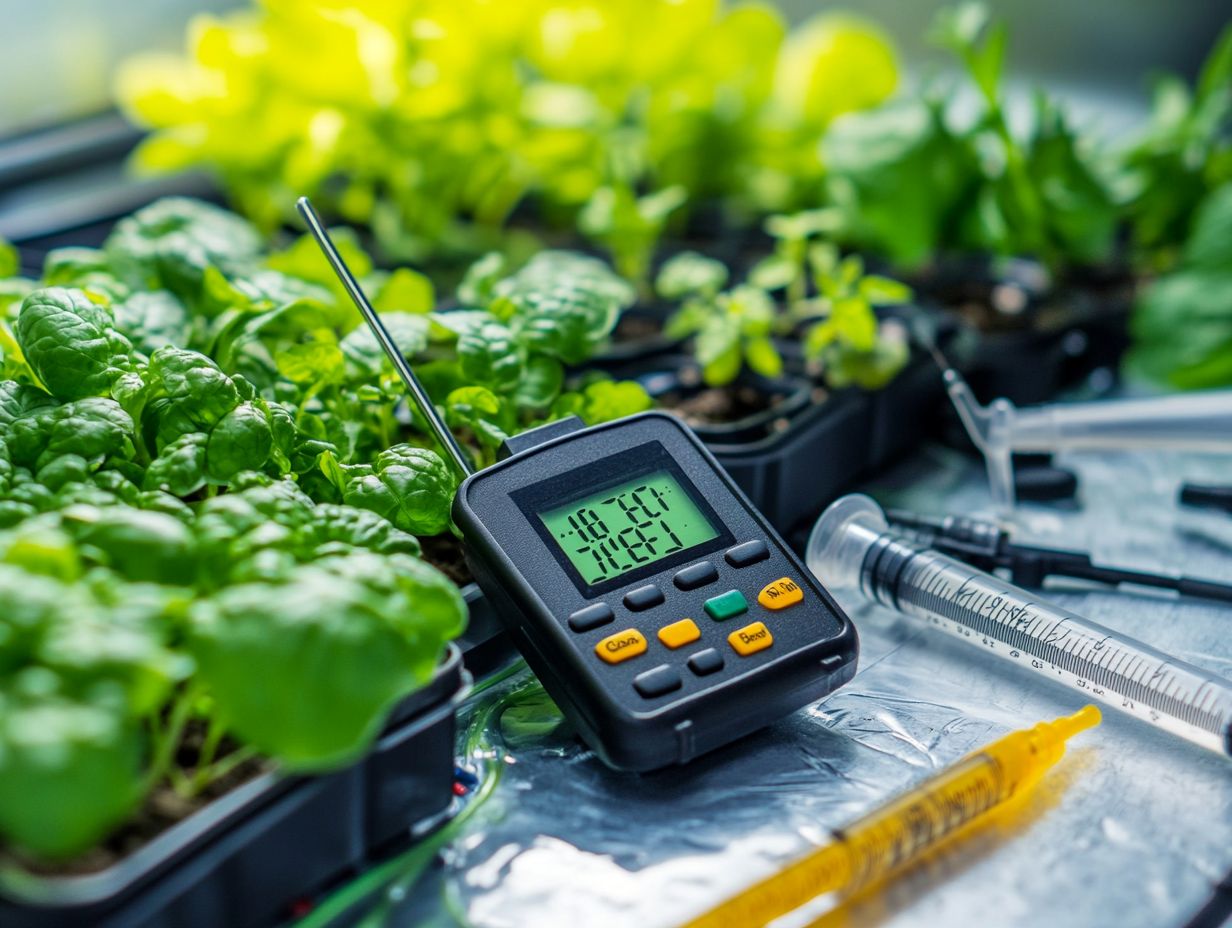
- Regularly checking EC levels is key to a successful hydroponic garden. It shows you the nutrient levels in your water.
- Manual testing with a meter and automated monitoring systems are both effective methods for measuring EC levels in hydroponics.
- Water quality, nutrient solutions, and environmental conditions can all affect EC levels. It’s important to regularly adjust and maintain optimal levels for healthy plant growth.
What is EC and Why is it Important?
Electrical conductivity (EC) is an essential measurement in hydroponics. It serves as a reliable indicator of the concentration of dissolved salts in your nutrient solution. This directly impacts nutrient availability and the health of your plants.
By understanding EC levels, you can effectively manage your nutrient solutions, creating the best growth conditions for a variety of hydroponic crops. Be mindful that high EC levels can lead to nutrient deficiencies or toxicities, while low levels may cause nutrient lockout. For more insights on maintaining optimal conditions, including troubleshooting pH levels in hydroponic gardens, both of which can severely hinder plant growth.
Therefore, regular monitoring of EC is crucial for maintaining the right nutrient balance in the root zone. For more insights, check out these tips for monitoring nutrient levels effectively, ultimately influencing your overall crop yield.
Methods for Monitoring EC Levels
Monitoring EC levels in hydroponic systems is essential for optimizing nutrient availability. You have several effective methods at your disposal for measuring EC, including EC meters and TDS meters, which deliver precise readings of electrical conductivity in parts per million (PPM).
Utilizing these devices gives you the power to make timely adjustments to your nutrient solutions, helping to prevent deficiencies and promoting healthy plant growth. By regularly checking your EC levels and understanding how to test nutrient levels in hydroponics, you can maintain a balanced composition of mineral ions in your nutrient solutions, ultimately leading to impressive crop yields.
Manual Testing with a Meter
Manual testing with an EC meter is a straightforward approach to assessing electrical conductivity in hydroponic systems. This method allows you to measure the total amount of dissolved solids and gain insight into the concentration of mineral ions in your nutrient solutions.
By adhering to a simple set of steps, you can ensure precise measurements that are essential for maintaining a balanced environment conducive to plant growth.
- Start by calibrating the EC meter with a standard solution to guarantee accuracy.
- Next, take a small sample of the nutrient solution and place it in a clean container.
- Immerse the EC probe into the liquid, making sure it doesn t touch the sides of the container, and wait for the reading to stabilize.
Understanding these measurements is crucial; they give you the power to identify potential nutrient deficiencies, enabling you to make informed adjustments to your feeding regimen. Regular manual testing not only optimizes plant health but also enhances yields, establishing it as an invaluable practice in hydroponics.
Automated Monitoring Systems
Automated monitoring systems are becoming critical in hydroponics. They offer you continuous measurement of electrical conductivity (EC), enabling you to maintain precise nutrient management and optimize growth conditions for your crops effortlessly.
These sophisticated setups enhance your efficiency by eliminating the need for laborious manual checks. They also significantly improve accuracy, ensuring that your readings remain reliable and consistent.
With real-time monitoring of EC levels at your fingertips, you can respond swiftly to any fluctuations, minimizing the risk of nutrient imbalances.
Better nutrient management leads to healthier plants, which ultimately results in higher yields and superior crop quality.
Embracing these advanced technologies marks a big change in your approach to hydroponic farming. This fosters a more sustainable and productive agricultural environment that benefits both you and your crops.
Interpreting EC Readings
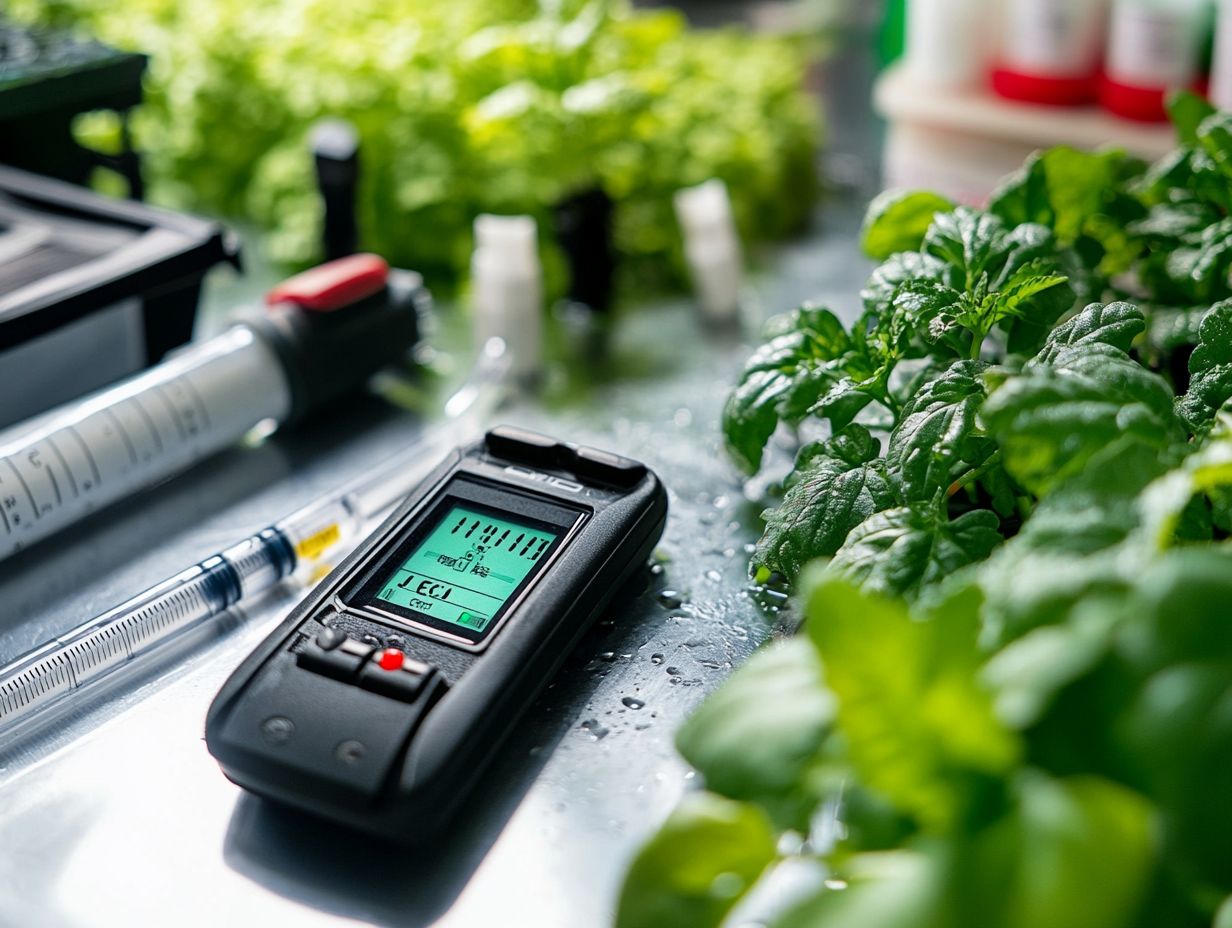
Understanding EC readings is essential for you as a hydroponic farmer. The ideal EC levels fluctuate depending on the specific plants and their growth stages, directly impacting nutrient availability in the root zone. This, in turn, plays a crucial role in determining the overall health and productivity of your plants.
Understanding Ideal EC Levels for Different Plants
Knowing the ideal EC levels for different hydroponic crops is crucial for ensuring optimal plant growth. Each species has specific nutrient requirements that demand precise adjustments to your nutrient solutions.
For example, if you’re cultivating leafy greens like lettuce, aim for an EC level of around 1.2 to 2.0. This range encourages lush growth and vibrant color. Conversely, if you’re growing fruiting plants such as tomatoes, you’ll need slightly higher levels, typically between 2.0 and 3.5, to support their greater nutrient uptake. To ensure you’re on the right track with your nutrient solution, check out this guide on how to test your hydroponic nutrient solution. Herbs, depending on their variety, generally thrive in a moderate range of 1.5 to 2.5.
By fine-tuning these nutrient ratios, you can significantly enhance both the health and yield of your crops. Adjustments may involve boosting potassium for fruits or balancing nitrogen for leafy greens, ensuring that each plant receives the optimal blend of nutrients essential for its unique growth phase.
Factors Affecting EC Levels
Several factors influence EC levels in hydroponic systems. These include the quality of your water, the prevailing environmental conditions, and the composition of your nutrient solutions. Each of these elements plays a crucial role in determining nutrient availability and ultimately impacts the health of your plants.
Water Quality and Nutrient Solutions
Water quality is vital in hydroponics. Your choice of water whether it s reverse osmosis or distilled can significantly impact the total dissolved solids (TDS) levels in your nutrient solutions, which in turn influences the electrical conductivity (EC) readings. TDS refers to the amount of different substances dissolved in the water.
Opting for reverse osmosis water typically results in lower TDS, giving you greater control over nutrient concentrations, essential for optimal plant growth. While distilled water is also low in impurities, it may have slightly different mineral profiles that could influence the overall nutrient balance.
Every decision you make regarding water type directly affects EC levels, a crucial indicator of nutrient availability for your plants. As a hydroponic gardener, it’s vital to consider how these water choices impact plant health. Insufficient or excessive nutrient levels can lead to deficiencies or toxicities, ultimately stunting the growth potential of your crops.
Start monitoring your EC levels today for optimal growth!
Environmental Conditions
Environmental conditions like temperature, humidity, and light greatly impact plant growth in hydroponics. These factors affect managing nutrients and can lead to problems like leaf burn if electrical conductivity (EC) levels aren’t monitored closely.
It s essential to maintain a delicate balance among these elements for optimal nutrient uptake. Even slight variations can hinder your plants’ ability to absorb essential minerals.
For instance, high temperatures can spike EC levels, leading to nutrient lockout. This condition prevents roots from accessing the nutrients they need, resulting in growth-stunting deficiencies.
Low humidity can also exacerbate the situation. It causes plants to lose water quickly, compelling them to focus on hydration rather than nutrient absorption.
Adapting these environmental conditions is vital for cultivating healthy, thriving plants. Keeping nutrient levels within optimal ranges is key to robust growth.
Maintaining Optimal EC Levels
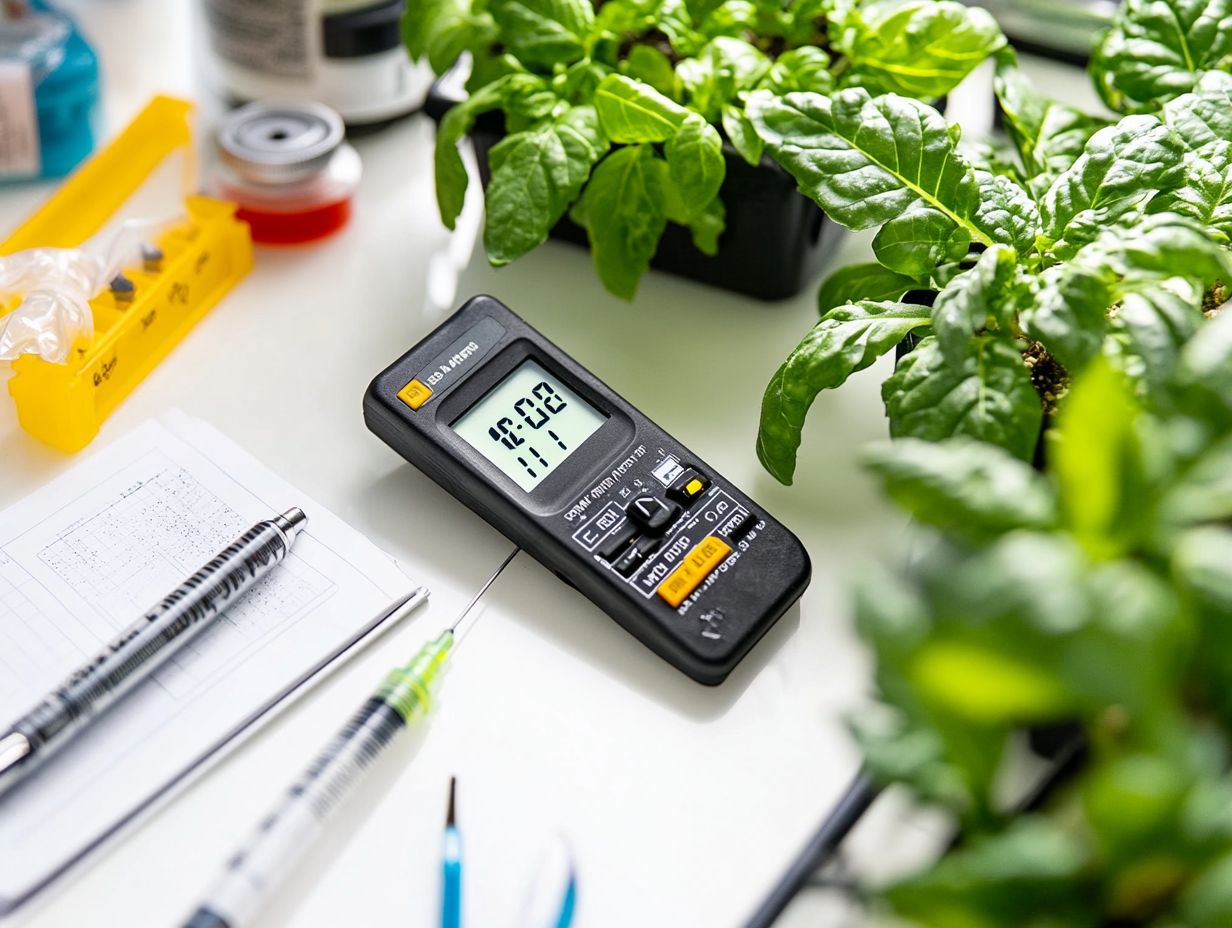
To succeed in hydroponic gardening, maintaining optimal EC levels is crucial. Regularly adjust nutrient solutions and refresh them as needed.
Utilize pH adjusters to ensure your plants get the vital nutrients required for healthy growth.
Adjusting EC Levels as Needed
Adjusting EC levels is necessary for providing your plants with a balanced diet of nutrients. You must monitor closely to ensure your plants thrive!
Keep a close watch on these variables to tweak your nutrient mixes effectively. You can elevate EC for nutrient-rich growth or dilute solutions if they become overly concentrated.
A practical tip is to gradually introduce additional nutrients or water, ensuring changes are made slowly to prevent shocking your plants.
Understanding the relationship between pH and EC can significantly improve nutrient uptake. Maintaining a pH of around 5.5 to 6.5 typically facilitates optimal nutrient availability.
Remember, fluctuations in pH can directly impact nutrient absorption, so keep both measures in harmony.
Troubleshooting Common EC Issues
Troubleshooting common EC issues is essential for maintaining strong hydroponic crops. Problems like nutrient deficiencies and leaf burn often arise from poor EC management.
Regularly monitor the electrical conductivity of your nutrient solution to catch fluctuations that may signal deeper issues. If you see an unexpected spike in EC readings, it s a sign of nutrient overload, leading to leaf burn.
Conversely, low readings may indicate a nutrient deficiency. To tackle these challenges, recalibrating your feeding schedules and adjusting nutrient concentrations is crucial.
Implementing a routine check of your EC levels enables early issue detection and enhances your plants overall vigor, leading to a more productive hydroponic system.
Frequently Asked Questions
What are EC levels and why are they important in hydroponics?
EC levels, or electrical conductivity, measure nutrient concentration in a hydroponic system. They indicate the health of the plant’s root zone and can impact plant growth and yield.
How can I measure EC levels in my hydroponic system?
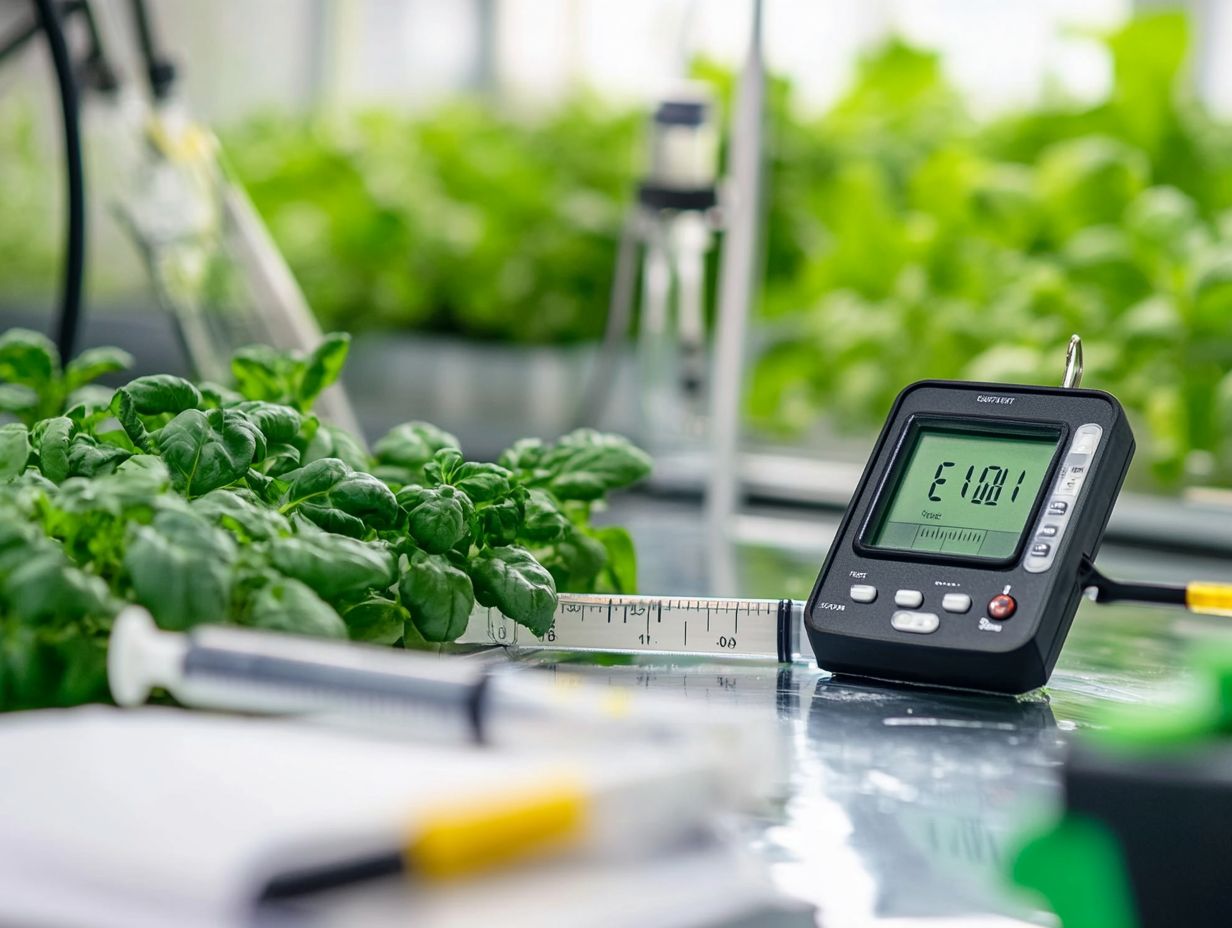
You can measure EC levels using a handheld EC meter, a continuous monitoring system, or test strips. Your choice will depend on your budget and desired accuracy.
What is the ideal range for EC levels in hydroponics?
The ideal EC range varies based on the plant type and growth stage. Generally, most plants thrive in a range of 1.2-2.0 mS/cm (millisiemens per centimeter).
How often should I monitor EC levels in my hydroponic system?
Monitor your EC levels daily in a hydroponic system. This helps you quickly spot changes and make necessary adjustments to keep your plants thriving!
What factors can affect EC levels in a hydroponic system?
Many factors influence EC levels. These include the type and concentration of nutrients, water quality, temperature, and the overall health of your plants.
Regularly check these factors to maintain the right EC levels.
Can I reuse the nutrient solution in my hydroponic system?
You can reuse the nutrient solution, but keep an eye on the EC levels. As plants absorb nutrients, the EC levels will drop.
Be ready to replenish or adjust the solution to keep it at optimal levels!
Start monitoring your EC levels proactively to ensure your plants receive the best care!

